Positive Behaviour Support Plan: Child Assessment and Strategies
VerifiedAdded on 2023/04/17
|14
|2545
|75
Project
AI Summary
This project presents a comprehensive positive behavior support plan (PBSP) for a child named Darcy, focusing on trauma-informed care and behavior management. It begins with background information, including the child's history of care, trauma background, strengths, and emotional/physical presentation. The assessment responses detail two positive behaviors, analyzing their origins, purposes, triggers, and staff response strategies, followed by reparative strategies. The project then identifies and analyzes three current behaviors of concern (problematic sexual behavior, absconding, and aggressive behavior), exploring their origins and impacts. Finally, it formulates three behavior management and change plans, providing preventative, environmental, skill-building, and response strategies for each identified behavior, offering a practical approach to support the child's wellbeing and address challenging behaviors within a care setting.
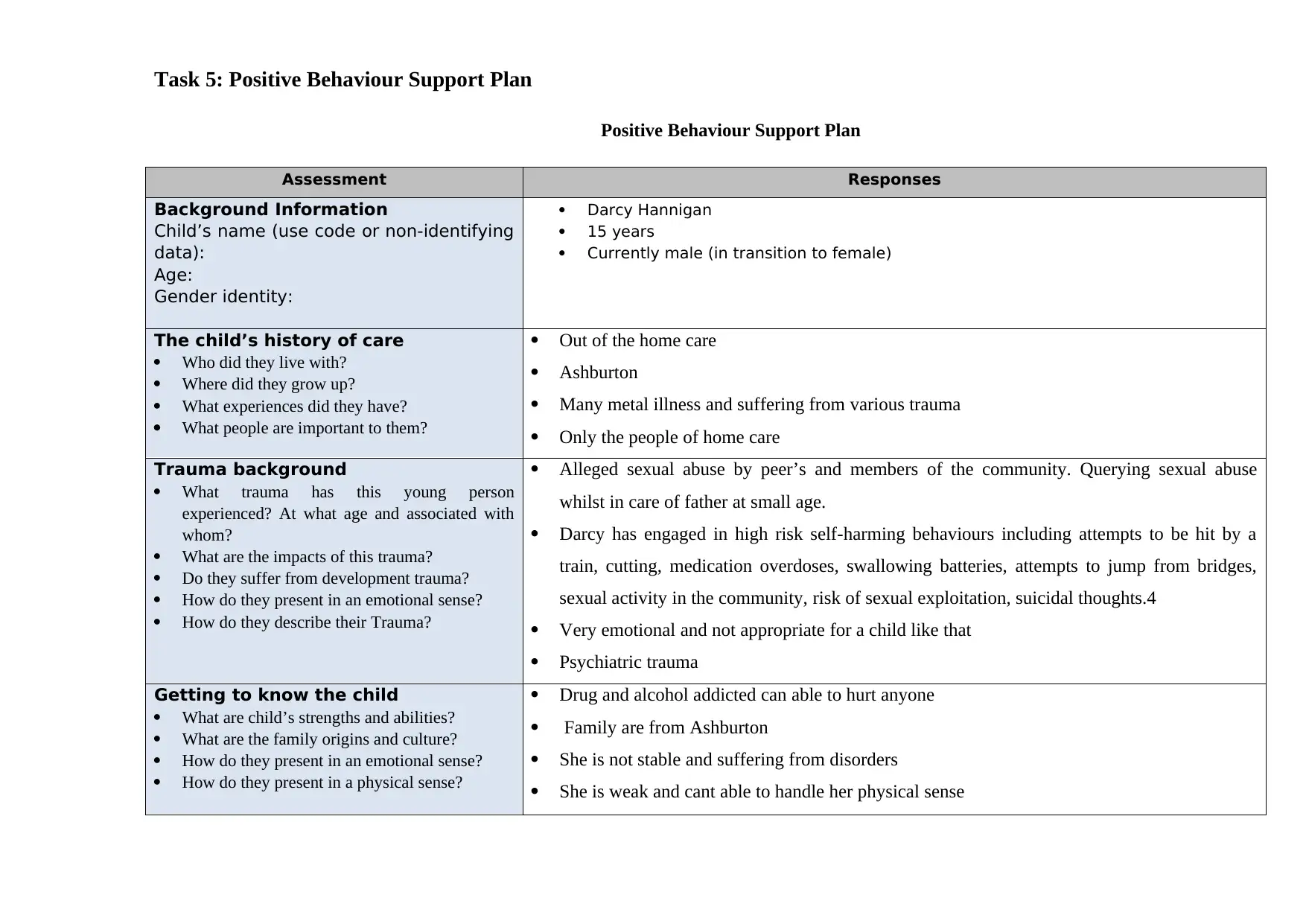
Task 5: Positive Behaviour Support Plan
Positive Behaviour Support Plan
Assessment Responses
Background Information
Child’s name (use code or non-identifying
data):
Age:
Gender identity:
Darcy Hannigan
15 years
Currently male (in transition to female)
The child’s history of care
Who did they live with?
Where did they grow up?
What experiences did they have?
What people are important to them?
Out of the home care
Ashburton
Many metal illness and suffering from various trauma
Only the people of home care
Trauma background
What trauma has this young person
experienced? At what age and associated with
whom?
What are the impacts of this trauma?
Do they suffer from development trauma?
How do they present in an emotional sense?
How do they describe their Trauma?
Alleged sexual abuse by peer’s and members of the community. Querying sexual abuse
whilst in care of father at small age.
Darcy has engaged in high risk self-harming behaviours including attempts to be hit by a
train, cutting, medication overdoses, swallowing batteries, attempts to jump from bridges,
sexual activity in the community, risk of sexual exploitation, suicidal thoughts.4
Very emotional and not appropriate for a child like that
Psychiatric trauma
Getting to know the child
What are child’s strengths and abilities?
What are the family origins and culture?
How do they present in an emotional sense?
How do they present in a physical sense?
Drug and alcohol addicted can able to hurt anyone
Family are from Ashburton
She is not stable and suffering from disorders
She is weak and cant able to handle her physical sense
Positive Behaviour Support Plan
Assessment Responses
Background Information
Child’s name (use code or non-identifying
data):
Age:
Gender identity:
Darcy Hannigan
15 years
Currently male (in transition to female)
The child’s history of care
Who did they live with?
Where did they grow up?
What experiences did they have?
What people are important to them?
Out of the home care
Ashburton
Many metal illness and suffering from various trauma
Only the people of home care
Trauma background
What trauma has this young person
experienced? At what age and associated with
whom?
What are the impacts of this trauma?
Do they suffer from development trauma?
How do they present in an emotional sense?
How do they describe their Trauma?
Alleged sexual abuse by peer’s and members of the community. Querying sexual abuse
whilst in care of father at small age.
Darcy has engaged in high risk self-harming behaviours including attempts to be hit by a
train, cutting, medication overdoses, swallowing batteries, attempts to jump from bridges,
sexual activity in the community, risk of sexual exploitation, suicidal thoughts.4
Very emotional and not appropriate for a child like that
Psychiatric trauma
Getting to know the child
What are child’s strengths and abilities?
What are the family origins and culture?
How do they present in an emotional sense?
How do they present in a physical sense?
Drug and alcohol addicted can able to hurt anyone
Family are from Ashburton
She is not stable and suffering from disorders
She is weak and cant able to handle her physical sense
Paraphrase This Document
Need a fresh take? Get an instant paraphrase of this document with our AI Paraphraser
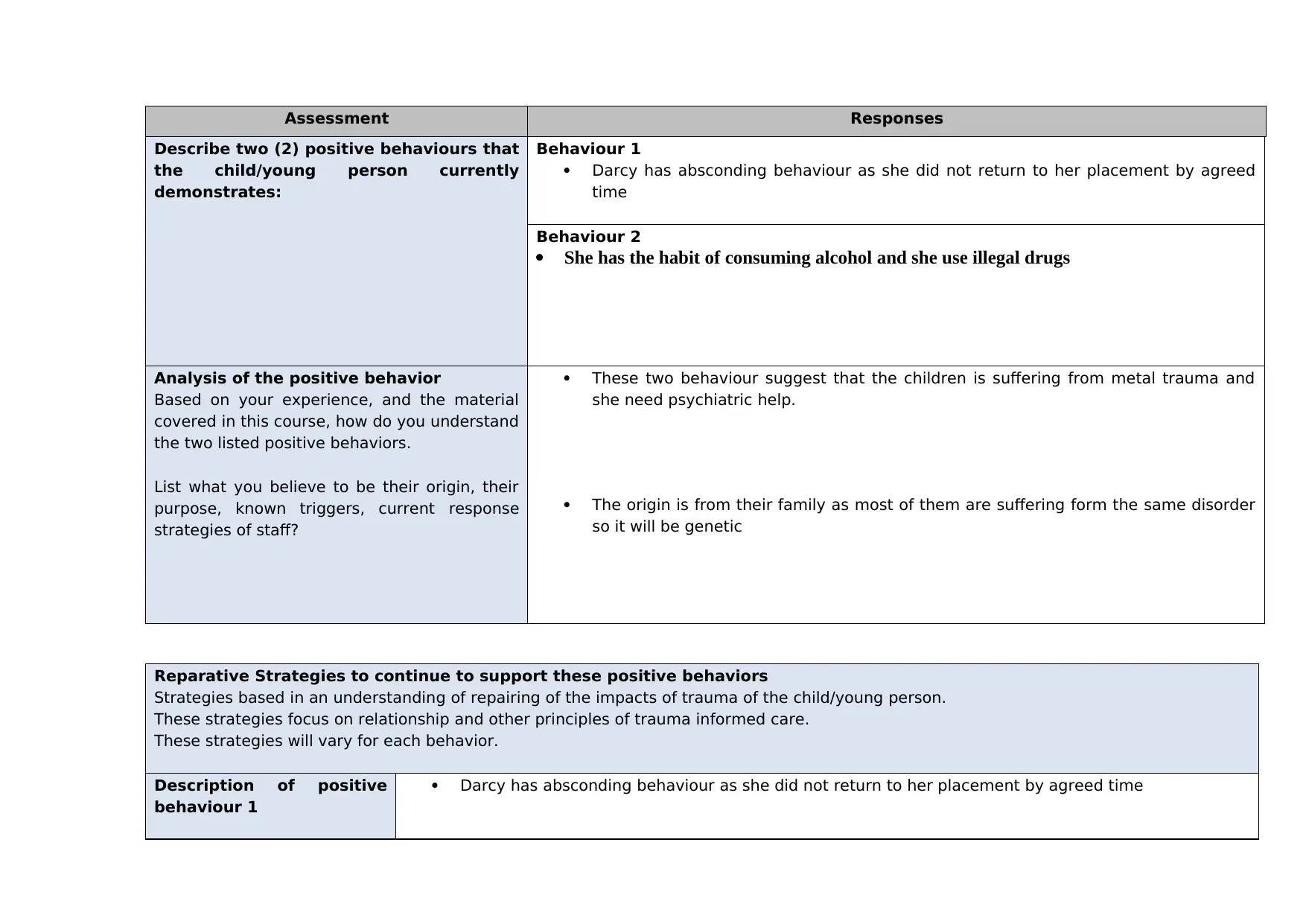
Assessment Responses
Describe two (2) positive behaviours that
the child/young person currently
demonstrates:
Behaviour 1
Darcy has absconding behaviour as she did not return to her placement by agreed
time
Behaviour 2
She has the habit of consuming alcohol and she use illegal drugs
Analysis of the positive behavior
Based on your experience, and the material
covered in this course, how do you understand
the two listed positive behaviors.
List what you believe to be their origin, their
purpose, known triggers, current response
strategies of staff?
These two behaviour suggest that the children is suffering from metal trauma and
she need psychiatric help.
The origin is from their family as most of them are suffering form the same disorder
so it will be genetic
Reparative Strategies to continue to support these positive behaviors
Strategies based in an understanding of repairing of the impacts of trauma of the child/young person.
These strategies focus on relationship and other principles of trauma informed care.
These strategies will vary for each behavior.
Description of positive
behaviour 1
Darcy has absconding behaviour as she did not return to her placement by agreed time
Describe two (2) positive behaviours that
the child/young person currently
demonstrates:
Behaviour 1
Darcy has absconding behaviour as she did not return to her placement by agreed
time
Behaviour 2
She has the habit of consuming alcohol and she use illegal drugs
Analysis of the positive behavior
Based on your experience, and the material
covered in this course, how do you understand
the two listed positive behaviors.
List what you believe to be their origin, their
purpose, known triggers, current response
strategies of staff?
These two behaviour suggest that the children is suffering from metal trauma and
she need psychiatric help.
The origin is from their family as most of them are suffering form the same disorder
so it will be genetic
Reparative Strategies to continue to support these positive behaviors
Strategies based in an understanding of repairing of the impacts of trauma of the child/young person.
These strategies focus on relationship and other principles of trauma informed care.
These strategies will vary for each behavior.
Description of positive
behaviour 1
Darcy has absconding behaviour as she did not return to her placement by agreed time
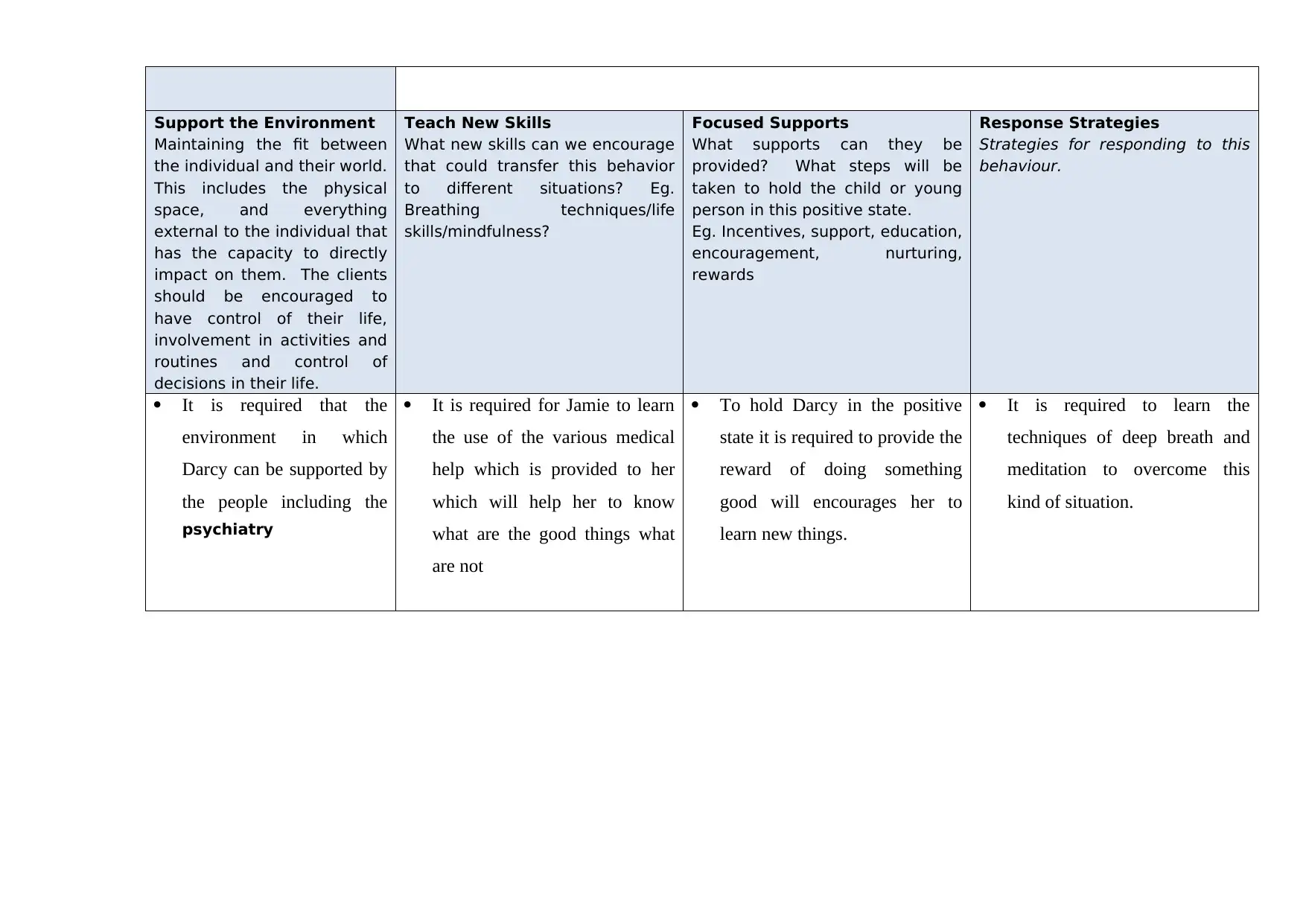
Support the Environment
Maintaining the fit between
the individual and their world.
This includes the physical
space, and everything
external to the individual that
has the capacity to directly
impact on them. The clients
should be encouraged to
have control of their life,
involvement in activities and
routines and control of
decisions in their life.
Teach New Skills
What new skills can we encourage
that could transfer this behavior
to different situations? Eg.
Breathing techniques/life
skills/mindfulness?
Focused Supports
What supports can they be
provided? What steps will be
taken to hold the child or young
person in this positive state.
Eg. Incentives, support, education,
encouragement, nurturing,
rewards
Response Strategies
Strategies for responding to this
behaviour.
It is required that the
environment in which
Darcy can be supported by
the people including the
psychiatry
It is required for Jamie to learn
the use of the various medical
help which is provided to her
which will help her to know
what are the good things what
are not
To hold Darcy in the positive
state it is required to provide the
reward of doing something
good will encourages her to
learn new things.
It is required to learn the
techniques of deep breath and
meditation to overcome this
kind of situation.
Maintaining the fit between
the individual and their world.
This includes the physical
space, and everything
external to the individual that
has the capacity to directly
impact on them. The clients
should be encouraged to
have control of their life,
involvement in activities and
routines and control of
decisions in their life.
Teach New Skills
What new skills can we encourage
that could transfer this behavior
to different situations? Eg.
Breathing techniques/life
skills/mindfulness?
Focused Supports
What supports can they be
provided? What steps will be
taken to hold the child or young
person in this positive state.
Eg. Incentives, support, education,
encouragement, nurturing,
rewards
Response Strategies
Strategies for responding to this
behaviour.
It is required that the
environment in which
Darcy can be supported by
the people including the
psychiatry
It is required for Jamie to learn
the use of the various medical
help which is provided to her
which will help her to know
what are the good things what
are not
To hold Darcy in the positive
state it is required to provide the
reward of doing something
good will encourages her to
learn new things.
It is required to learn the
techniques of deep breath and
meditation to overcome this
kind of situation.
⊘ This is a preview!⊘
Do you want full access?
Subscribe today to unlock all pages.

Trusted by 1+ million students worldwide
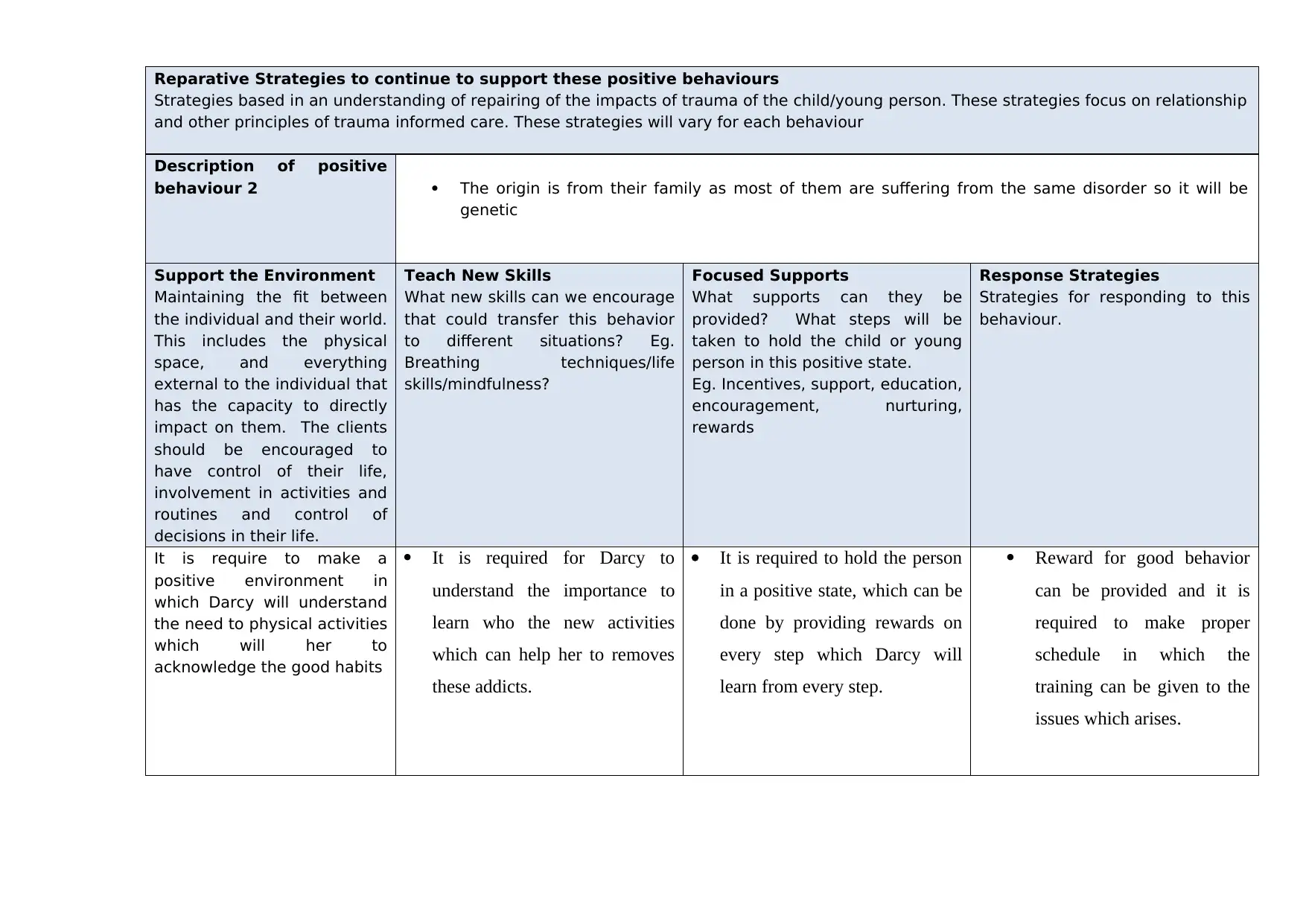
Reparative Strategies to continue to support these positive behaviours
Strategies based in an understanding of repairing of the impacts of trauma of the child/young person. These strategies focus on relationship
and other principles of trauma informed care. These strategies will vary for each behaviour
Description of positive
behaviour 2 The origin is from their family as most of them are suffering from the same disorder so it will be
genetic
Support the Environment
Maintaining the fit between
the individual and their world.
This includes the physical
space, and everything
external to the individual that
has the capacity to directly
impact on them. The clients
should be encouraged to
have control of their life,
involvement in activities and
routines and control of
decisions in their life.
Teach New Skills
What new skills can we encourage
that could transfer this behavior
to different situations? Eg.
Breathing techniques/life
skills/mindfulness?
Focused Supports
What supports can they be
provided? What steps will be
taken to hold the child or young
person in this positive state.
Eg. Incentives, support, education,
encouragement, nurturing,
rewards
Response Strategies
Strategies for responding to this
behaviour.
It is require to make a
positive environment in
which Darcy will understand
the need to physical activities
which will her to
acknowledge the good habits
It is required for Darcy to
understand the importance to
learn who the new activities
which can help her to removes
these addicts.
It is required to hold the person
in a positive state, which can be
done by providing rewards on
every step which Darcy will
learn from every step.
Reward for good behavior
can be provided and it is
required to make proper
schedule in which the
training can be given to the
issues which arises.
Strategies based in an understanding of repairing of the impacts of trauma of the child/young person. These strategies focus on relationship
and other principles of trauma informed care. These strategies will vary for each behaviour
Description of positive
behaviour 2 The origin is from their family as most of them are suffering from the same disorder so it will be
genetic
Support the Environment
Maintaining the fit between
the individual and their world.
This includes the physical
space, and everything
external to the individual that
has the capacity to directly
impact on them. The clients
should be encouraged to
have control of their life,
involvement in activities and
routines and control of
decisions in their life.
Teach New Skills
What new skills can we encourage
that could transfer this behavior
to different situations? Eg.
Breathing techniques/life
skills/mindfulness?
Focused Supports
What supports can they be
provided? What steps will be
taken to hold the child or young
person in this positive state.
Eg. Incentives, support, education,
encouragement, nurturing,
rewards
Response Strategies
Strategies for responding to this
behaviour.
It is require to make a
positive environment in
which Darcy will understand
the need to physical activities
which will her to
acknowledge the good habits
It is required for Darcy to
understand the importance to
learn who the new activities
which can help her to removes
these addicts.
It is required to hold the person
in a positive state, which can be
done by providing rewards on
every step which Darcy will
learn from every step.
Reward for good behavior
can be provided and it is
required to make proper
schedule in which the
training can be given to the
issues which arises.
Paraphrase This Document
Need a fresh take? Get an instant paraphrase of this document with our AI Paraphraser
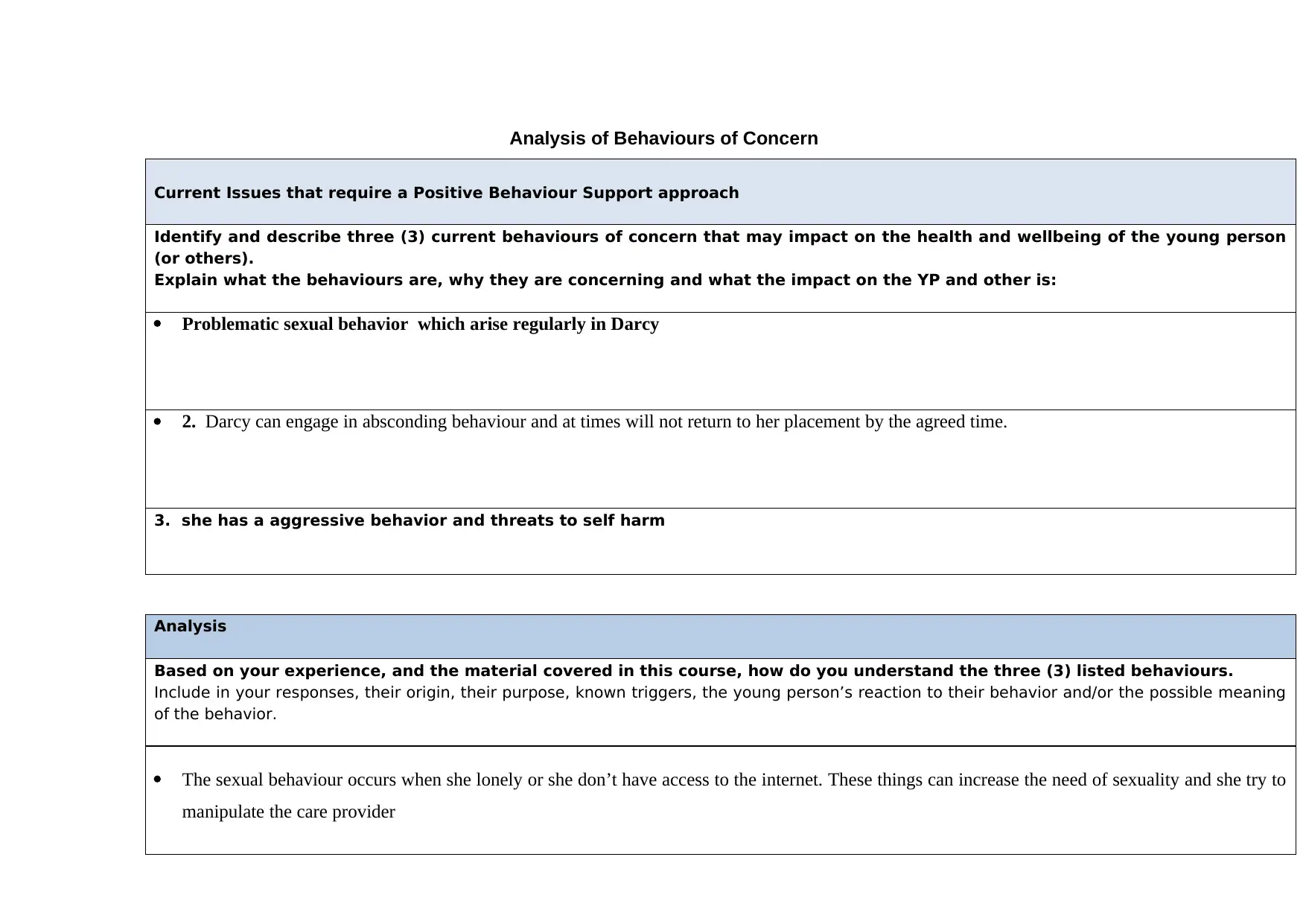
Analysis of Behaviours of Concern
Current Issues that require a Positive Behaviour Support approach
Identify and describe three (3) current behaviours of concern that may impact on the health and wellbeing of the young person
(or others).
Explain what the behaviours are, why they are concerning and what the impact on the YP and other is:
Problematic sexual behavior which arise regularly in Darcy
2. Darcy can engage in absconding behaviour and at times will not return to her placement by the agreed time.
3. she has a aggressive behavior and threats to self harm
Analysis
Based on your experience, and the material covered in this course, how do you understand the three (3) listed behaviours.
Include in your responses, their origin, their purpose, known triggers, the young person’s reaction to their behavior and/or the possible meaning
of the behavior.
The sexual behaviour occurs when she lonely or she don’t have access to the internet. These things can increase the need of sexuality and she try to
manipulate the care provider
Current Issues that require a Positive Behaviour Support approach
Identify and describe three (3) current behaviours of concern that may impact on the health and wellbeing of the young person
(or others).
Explain what the behaviours are, why they are concerning and what the impact on the YP and other is:
Problematic sexual behavior which arise regularly in Darcy
2. Darcy can engage in absconding behaviour and at times will not return to her placement by the agreed time.
3. she has a aggressive behavior and threats to self harm
Analysis
Based on your experience, and the material covered in this course, how do you understand the three (3) listed behaviours.
Include in your responses, their origin, their purpose, known triggers, the young person’s reaction to their behavior and/or the possible meaning
of the behavior.
The sexual behaviour occurs when she lonely or she don’t have access to the internet. These things can increase the need of sexuality and she try to
manipulate the care provider
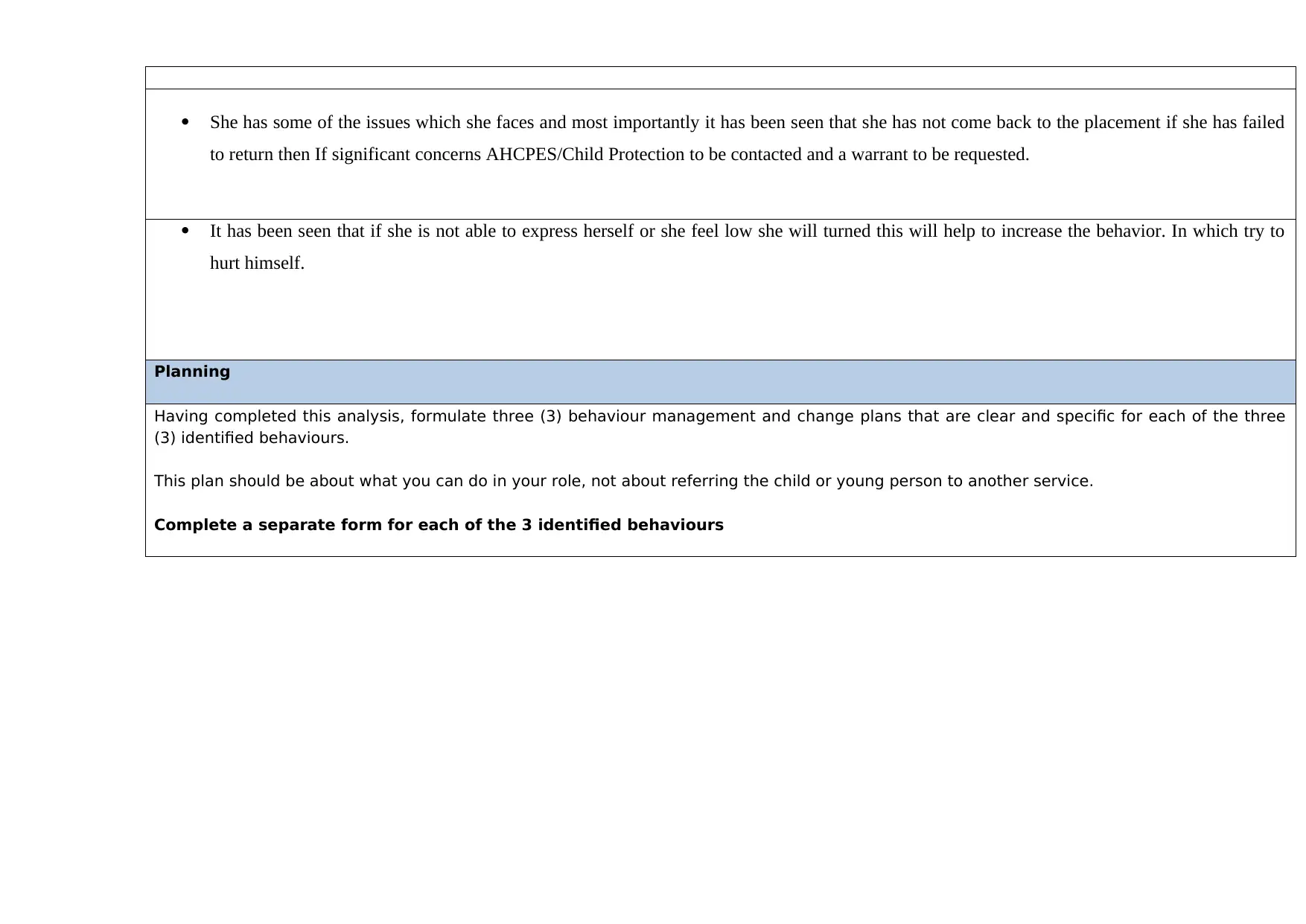
She has some of the issues which she faces and most importantly it has been seen that she has not come back to the placement if she has failed
to return then If significant concerns AHCPES/Child Protection to be contacted and a warrant to be requested.
It has been seen that if she is not able to express herself or she feel low she will turned this will help to increase the behavior. In which try to
hurt himself.
Planning
Having completed this analysis, formulate three (3) behaviour management and change plans that are clear and specific for each of the three
(3) identified behaviours.
This plan should be about what you can do in your role, not about referring the child or young person to another service.
Complete a separate form for each of the 3 identified behaviours
to return then If significant concerns AHCPES/Child Protection to be contacted and a warrant to be requested.
It has been seen that if she is not able to express herself or she feel low she will turned this will help to increase the behavior. In which try to
hurt himself.
Planning
Having completed this analysis, formulate three (3) behaviour management and change plans that are clear and specific for each of the three
(3) identified behaviours.
This plan should be about what you can do in your role, not about referring the child or young person to another service.
Complete a separate form for each of the 3 identified behaviours
⊘ This is a preview!⊘
Do you want full access?
Subscribe today to unlock all pages.

Trusted by 1+ million students worldwide
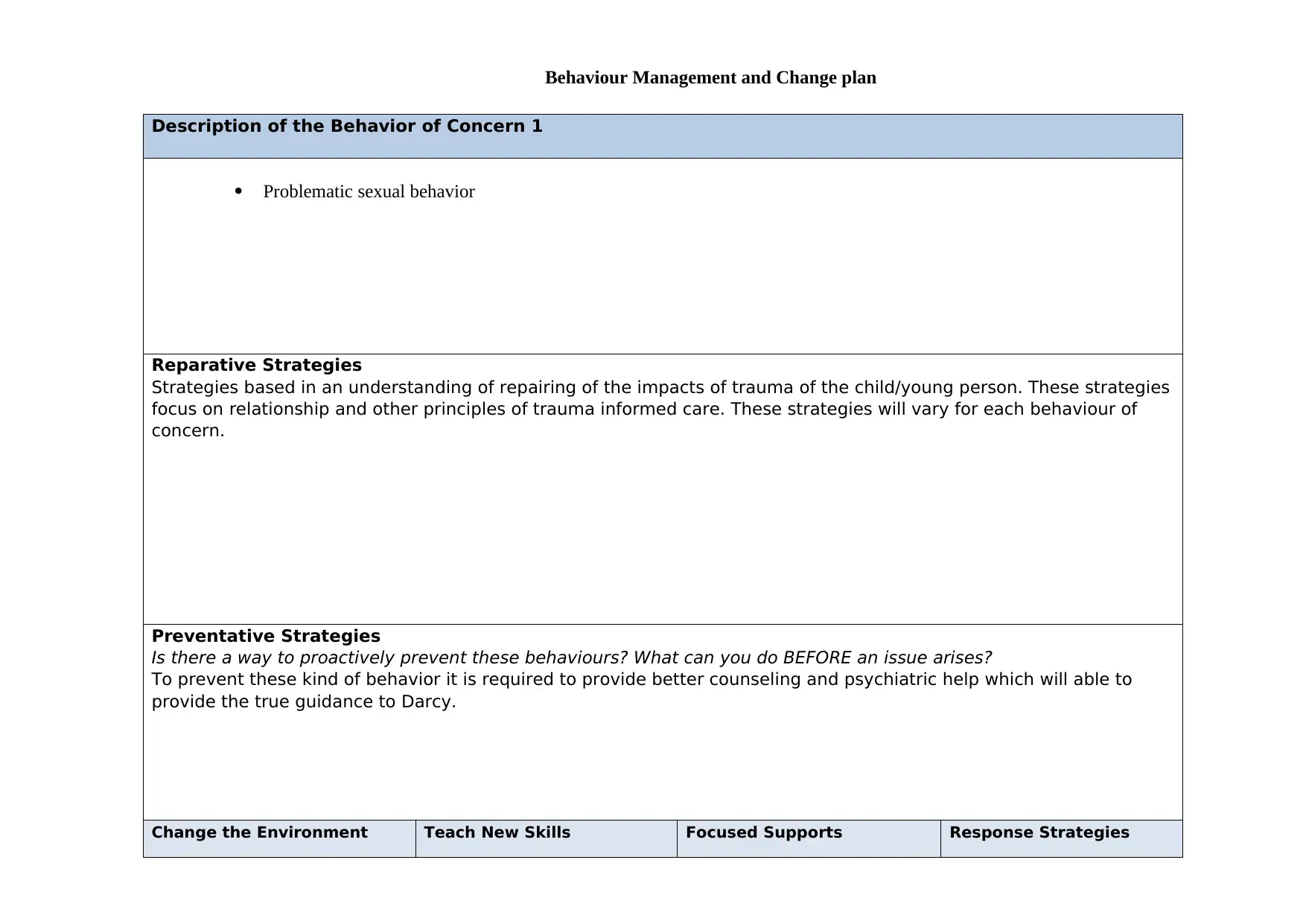
Behaviour Management and Change plan
Description of the Behavior of Concern 1
Problematic sexual behavior
Reparative Strategies
Strategies based in an understanding of repairing of the impacts of trauma of the child/young person. These strategies
focus on relationship and other principles of trauma informed care. These strategies will vary for each behaviour of
concern.
Preventative Strategies
Is there a way to proactively prevent these behaviours? What can you do BEFORE an issue arises?
To prevent these kind of behavior it is required to provide better counseling and psychiatric help which will able to
provide the true guidance to Darcy.
Change the Environment Teach New Skills Focused Supports Response Strategies
Description of the Behavior of Concern 1
Problematic sexual behavior
Reparative Strategies
Strategies based in an understanding of repairing of the impacts of trauma of the child/young person. These strategies
focus on relationship and other principles of trauma informed care. These strategies will vary for each behaviour of
concern.
Preventative Strategies
Is there a way to proactively prevent these behaviours? What can you do BEFORE an issue arises?
To prevent these kind of behavior it is required to provide better counseling and psychiatric help which will able to
provide the true guidance to Darcy.
Change the Environment Teach New Skills Focused Supports Response Strategies
Paraphrase This Document
Need a fresh take? Get an instant paraphrase of this document with our AI Paraphraser
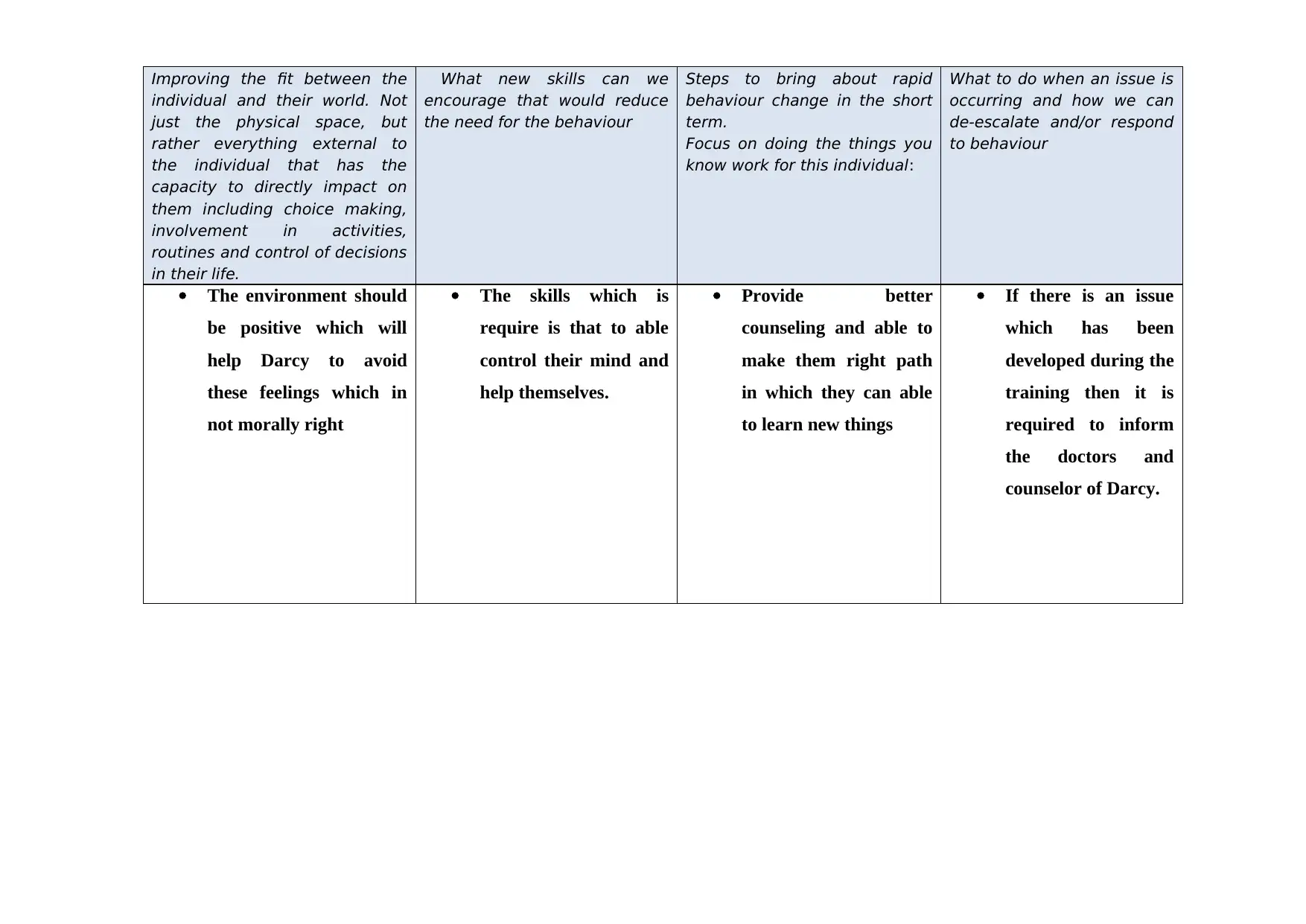
Improving the fit between the
individual and their world. Not
just the physical space, but
rather everything external to
the individual that has the
capacity to directly impact on
them including choice making,
involvement in activities,
routines and control of decisions
in their life.
What new skills can we
encourage that would reduce
the need for the behaviour
Steps to bring about rapid
behaviour change in the short
term.
Focus on doing the things you
know work for this individual:
What to do when an issue is
occurring and how we can
de-escalate and/or respond
to behaviour
The environment should
be positive which will
help Darcy to avoid
these feelings which in
not morally right
The skills which is
require is that to able
control their mind and
help themselves.
Provide better
counseling and able to
make them right path
in which they can able
to learn new things
If there is an issue
which has been
developed during the
training then it is
required to inform
the doctors and
counselor of Darcy.
individual and their world. Not
just the physical space, but
rather everything external to
the individual that has the
capacity to directly impact on
them including choice making,
involvement in activities,
routines and control of decisions
in their life.
What new skills can we
encourage that would reduce
the need for the behaviour
Steps to bring about rapid
behaviour change in the short
term.
Focus on doing the things you
know work for this individual:
What to do when an issue is
occurring and how we can
de-escalate and/or respond
to behaviour
The environment should
be positive which will
help Darcy to avoid
these feelings which in
not morally right
The skills which is
require is that to able
control their mind and
help themselves.
Provide better
counseling and able to
make them right path
in which they can able
to learn new things
If there is an issue
which has been
developed during the
training then it is
required to inform
the doctors and
counselor of Darcy.
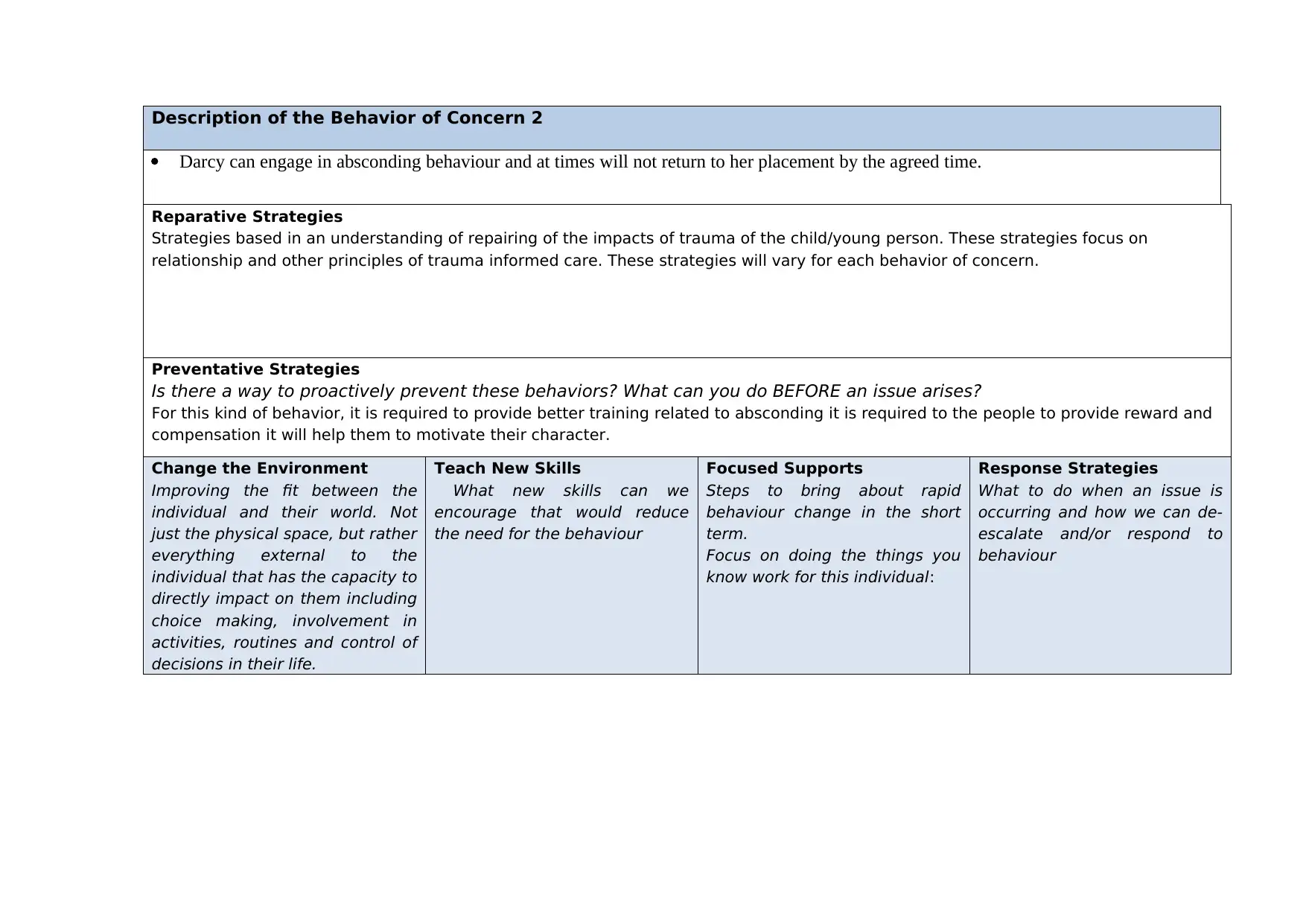
Description of the Behavior of Concern 2
Darcy can engage in absconding behaviour and at times will not return to her placement by the agreed time.
Reparative Strategies
Strategies based in an understanding of repairing of the impacts of trauma of the child/young person. These strategies focus on
relationship and other principles of trauma informed care. These strategies will vary for each behavior of concern.
Preventative Strategies
Is there a way to proactively prevent these behaviors? What can you do BEFORE an issue arises?
For this kind of behavior, it is required to provide better training related to absconding it is required to the people to provide reward and
compensation it will help them to motivate their character.
Change the Environment
Improving the fit between the
individual and their world. Not
just the physical space, but rather
everything external to the
individual that has the capacity to
directly impact on them including
choice making, involvement in
activities, routines and control of
decisions in their life.
Teach New Skills
What new skills can we
encourage that would reduce
the need for the behaviour
Focused Supports
Steps to bring about rapid
behaviour change in the short
term.
Focus on doing the things you
know work for this individual:
Response Strategies
What to do when an issue is
occurring and how we can de-
escalate and/or respond to
behaviour
Darcy can engage in absconding behaviour and at times will not return to her placement by the agreed time.
Reparative Strategies
Strategies based in an understanding of repairing of the impacts of trauma of the child/young person. These strategies focus on
relationship and other principles of trauma informed care. These strategies will vary for each behavior of concern.
Preventative Strategies
Is there a way to proactively prevent these behaviors? What can you do BEFORE an issue arises?
For this kind of behavior, it is required to provide better training related to absconding it is required to the people to provide reward and
compensation it will help them to motivate their character.
Change the Environment
Improving the fit between the
individual and their world. Not
just the physical space, but rather
everything external to the
individual that has the capacity to
directly impact on them including
choice making, involvement in
activities, routines and control of
decisions in their life.
Teach New Skills
What new skills can we
encourage that would reduce
the need for the behaviour
Focused Supports
Steps to bring about rapid
behaviour change in the short
term.
Focus on doing the things you
know work for this individual:
Response Strategies
What to do when an issue is
occurring and how we can de-
escalate and/or respond to
behaviour
⊘ This is a preview!⊘
Do you want full access?
Subscribe today to unlock all pages.

Trusted by 1+ million students worldwide
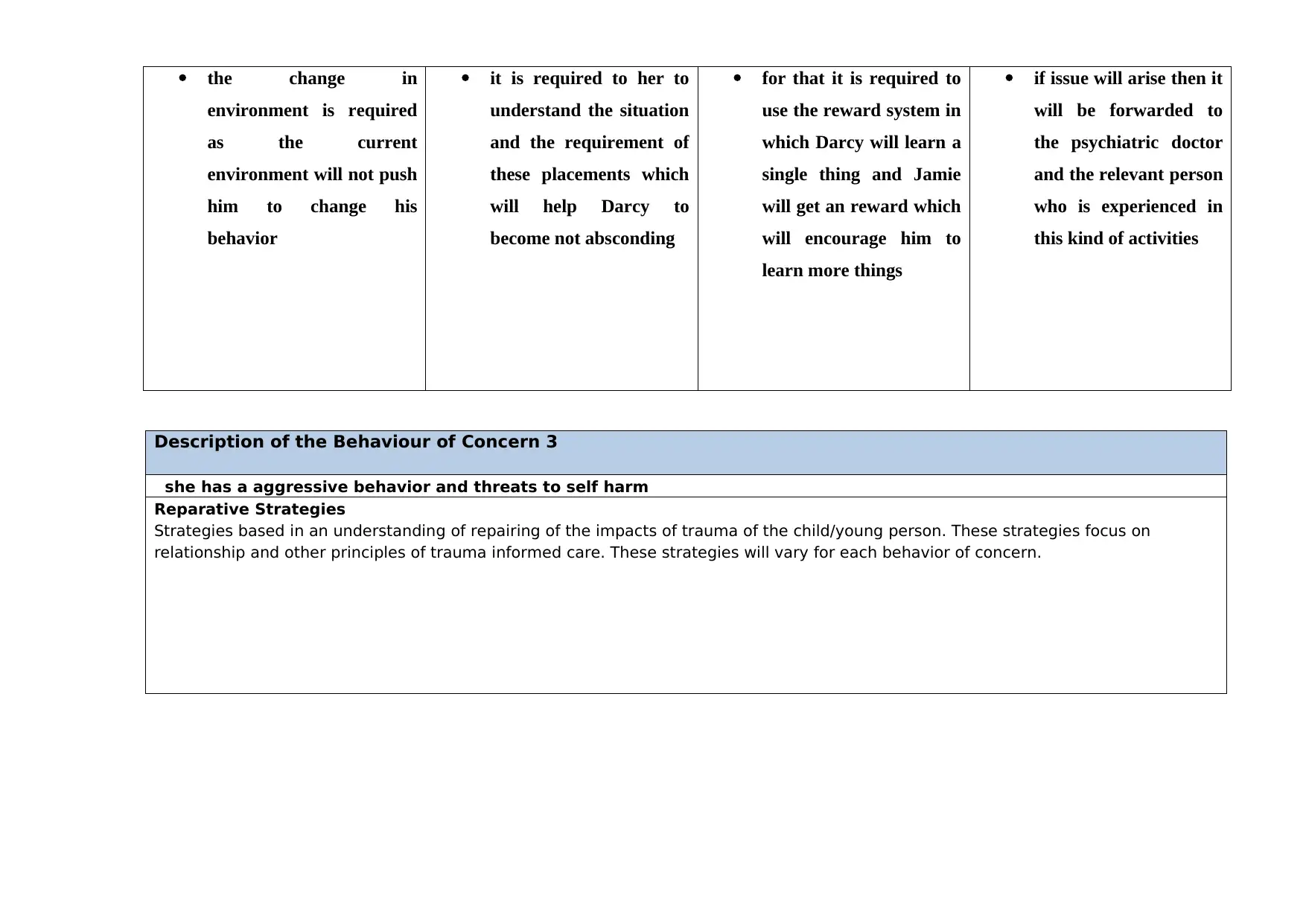
the change in
environment is required
as the current
environment will not push
him to change his
behavior
it is required to her to
understand the situation
and the requirement of
these placements which
will help Darcy to
become not absconding
for that it is required to
use the reward system in
which Darcy will learn a
single thing and Jamie
will get an reward which
will encourage him to
learn more things
if issue will arise then it
will be forwarded to
the psychiatric doctor
and the relevant person
who is experienced in
this kind of activities
Description of the Behaviour of Concern 3
she has a aggressive behavior and threats to self harm
Reparative Strategies
Strategies based in an understanding of repairing of the impacts of trauma of the child/young person. These strategies focus on
relationship and other principles of trauma informed care. These strategies will vary for each behavior of concern.
environment is required
as the current
environment will not push
him to change his
behavior
it is required to her to
understand the situation
and the requirement of
these placements which
will help Darcy to
become not absconding
for that it is required to
use the reward system in
which Darcy will learn a
single thing and Jamie
will get an reward which
will encourage him to
learn more things
if issue will arise then it
will be forwarded to
the psychiatric doctor
and the relevant person
who is experienced in
this kind of activities
Description of the Behaviour of Concern 3
she has a aggressive behavior and threats to self harm
Reparative Strategies
Strategies based in an understanding of repairing of the impacts of trauma of the child/young person. These strategies focus on
relationship and other principles of trauma informed care. These strategies will vary for each behavior of concern.
Paraphrase This Document
Need a fresh take? Get an instant paraphrase of this document with our AI Paraphraser
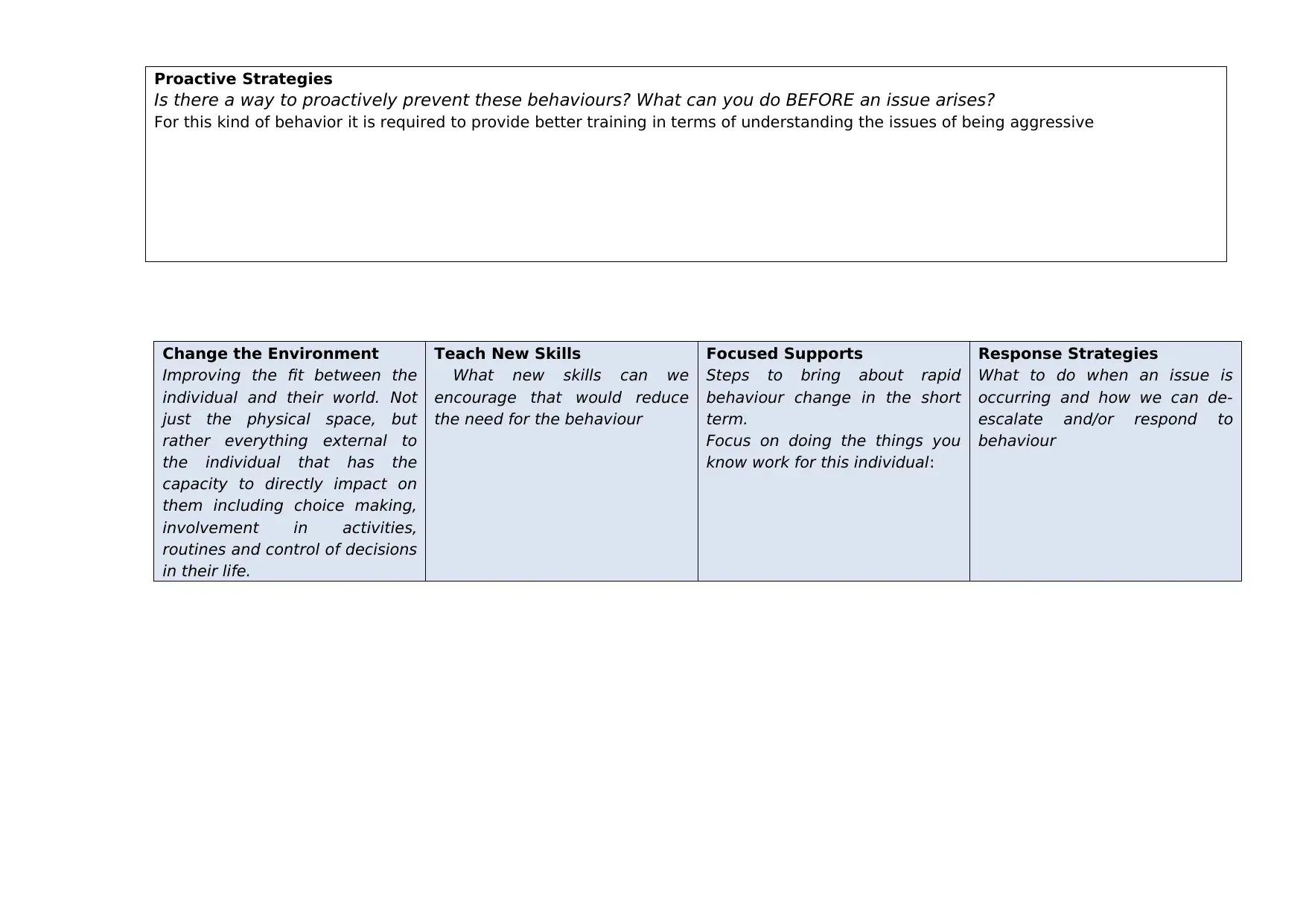
Proactive Strategies
Is there a way to proactively prevent these behaviours? What can you do BEFORE an issue arises?
For this kind of behavior it is required to provide better training in terms of understanding the issues of being aggressive
Change the Environment
Improving the fit between the
individual and their world. Not
just the physical space, but
rather everything external to
the individual that has the
capacity to directly impact on
them including choice making,
involvement in activities,
routines and control of decisions
in their life.
Teach New Skills
What new skills can we
encourage that would reduce
the need for the behaviour
Focused Supports
Steps to bring about rapid
behaviour change in the short
term.
Focus on doing the things you
know work for this individual:
Response Strategies
What to do when an issue is
occurring and how we can de-
escalate and/or respond to
behaviour
Is there a way to proactively prevent these behaviours? What can you do BEFORE an issue arises?
For this kind of behavior it is required to provide better training in terms of understanding the issues of being aggressive
Change the Environment
Improving the fit between the
individual and their world. Not
just the physical space, but
rather everything external to
the individual that has the
capacity to directly impact on
them including choice making,
involvement in activities,
routines and control of decisions
in their life.
Teach New Skills
What new skills can we
encourage that would reduce
the need for the behaviour
Focused Supports
Steps to bring about rapid
behaviour change in the short
term.
Focus on doing the things you
know work for this individual:
Response Strategies
What to do when an issue is
occurring and how we can de-
escalate and/or respond to
behaviour
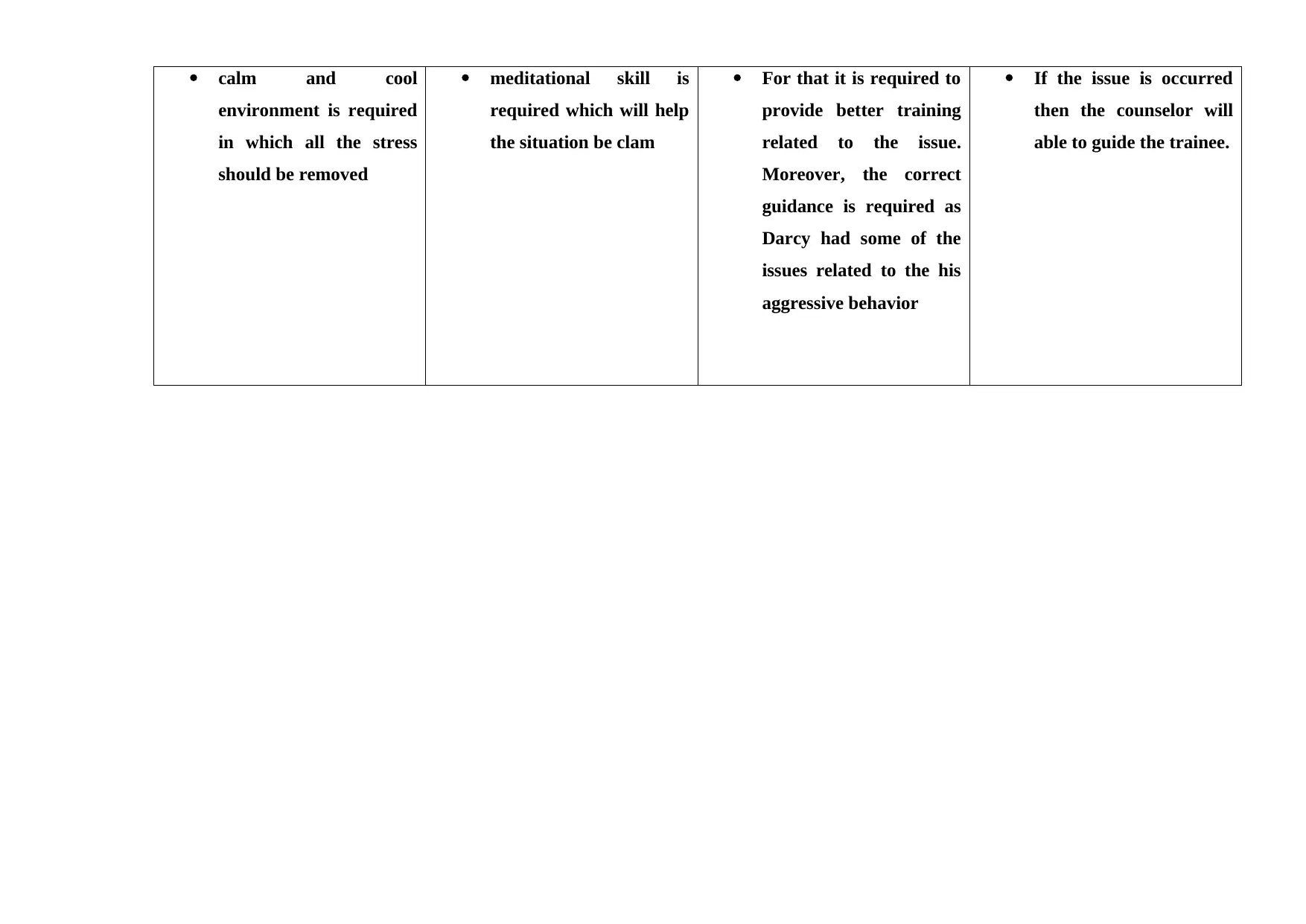
calm and cool
environment is required
in which all the stress
should be removed
meditational skill is
required which will help
the situation be clam
For that it is required to
provide better training
related to the issue.
Moreover, the correct
guidance is required as
Darcy had some of the
issues related to the his
aggressive behavior
If the issue is occurred
then the counselor will
able to guide the trainee.
environment is required
in which all the stress
should be removed
meditational skill is
required which will help
the situation be clam
For that it is required to
provide better training
related to the issue.
Moreover, the correct
guidance is required as
Darcy had some of the
issues related to the his
aggressive behavior
If the issue is occurred
then the counselor will
able to guide the trainee.
⊘ This is a preview!⊘
Do you want full access?
Subscribe today to unlock all pages.

Trusted by 1+ million students worldwide
1 out of 14
Your All-in-One AI-Powered Toolkit for Academic Success.
+13062052269
info@desklib.com
Available 24*7 on WhatsApp / Email
![[object Object]](/_next/static/media/star-bottom.7253800d.svg)
Unlock your academic potential
Copyright © 2020–2025 A2Z Services. All Rights Reserved. Developed and managed by ZUCOL.


